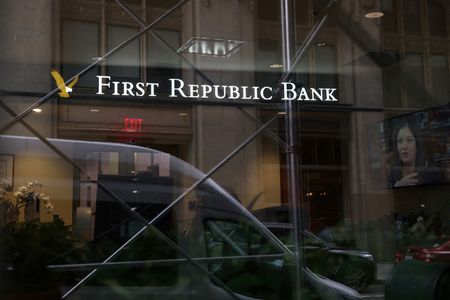
By Michael S. Derby
NEW YORK (Reuters) – Federal Reserve data on Thursday showed a large part of the central bank’s emergency lending activities in recent weeks were tied up with the now-shuttered First Republic Bank.
The Fed reported that while overall emergency lending to banks in the latest week tipped down a bit, the composition of the lending changed in key ways.
The Fed said that money the bank had borrowed via the discount window, the central bank’s main source of liquidity for banks, and through the Bank Term Funding Program, had now shifted to “other credit.” That covers loans associated with the Federal Deposition Insurance Corporation’s work to deal with several high-profile bank failures that kicked off in March and spurred broad fears about the state of the banking system.
The Fed reported that discount window borrowing fell to $5.3 billion on Wednesday from $73.9 billion the week before, while the BTFP saw loans slip to $75.8 billion, from $81.3 billion on April 26.
But “other credit,” which was already large due to past bank failures, got even bigger, jumping to $228.2 billion as of Wendnesday, from April 26’s $170.4 billion.
Steven Kelly, senior research associate at the Yale Program on Financial Stability, said the discount window borrowing decline was notable given that so much of it was linked to a single insitution, which argues against a broader crisis in the banking sector. “I hope that gets a headline and calms people down,” he said.
The still strong takeup at the BTFP might not be fully crisis related, as the facility offers very attractive terms and the Fed has encourged banks to tap its liquidity if needed.
In his press conference following the Fed’s quarter percentage point rate rise on Wendnesday, central bank leader Jerome Powell sought to stress what he saw as contained problems among banks.
Condtions in the banking sector “have broadly improved since early March, and the U.S banking system is sound and resilient,” Powell said.
Borrowing via the three main programs saw an overall decline in the latest week, moving to $309.3 billion on Wednesday, from $325.6 billion on April 26. Fed lending surged in March driven by banking sector troubles and has remained at very high levels since that initial surge.
TD Securities said in a note Thursday that the still high levels of overall borrowing from the Fed reflects “ongoing banking system uncertainty.”
(Reporting by Michael S. Derby; Editing by Chris Reese and Stephen Coates)

